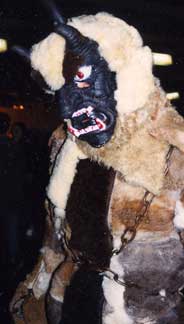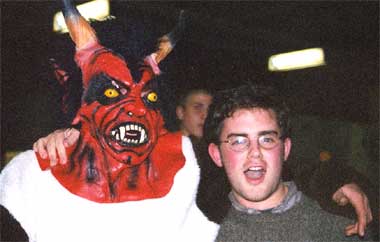Santa Claus may be a wonderful symbol of the holiday spirit, but time and consumer society have warped him to the point where he makes little sense. The idea behind Santa, originally, was to carrot-and-stick little boys and girls into good behavior—he’s got a list, he’s checking it twice, and if you fall under the ‘naughty’ category it’s switches and coals for you. But what child in America is at all afraid of receiving a lump of coal under the tree? What child even knows what a ‘switch’ is? Thanks to a range of factors—Dr. Spock and Mattel are high on the list—Santa’s beneficence is a fait accompli.
Alpine Europe, on the other hand, doesn’t have this problem. This is because years ago St. Nick’s job was split—while the jolly old elf delivered the goods, an evil, goat-horned spirit called the Krampus brought switches and bad dreams to the boys and girls of Austria, southern Germany, Switzerland, and far northern Italy.

And while many regional European traditions are giving way to international consumer culture (the fat, red-bedecked Santa is in fact quickly replacing the rail-thin St. Nick throughout the continent), the Krampus is alive and well. He even has his own day—December 5. His success is certainly thanks in part to the lack of a parallel in American society. But he has stuck around mostly because Krampus Fest, like most holidays in alpine Europe, is a beloved excuse for small towns to get together and drink their brains out.
According to Mannfred Kapper of the Austrian Cultural Forum, the Krampus was initially a side note to the St. Nicholas story, a goat-faced eminence noir who accompanied St. Nick on his December gift-giving tours. ‘Nicholas and Krampus would come to the houses together,’ Kapper said. ‘Nicholas gave the children presents and Krampus beat them.’ But in the last 200 years, Krampus has slowly developed an identity of his own. ‘Today Krampus is more popular in the countryside, but if you come to the city it is more St. Nicholas,’ he said.
A while back I spent a year in Jennersdorf, Austria, teaching English at the local high school. Jennersdorf is a stone’s throw from nothing, a southeastern village of 3,000 people a few miles from the Hungarian border. There I experienced a host of unimaginable traditions—I watched a man be wedded to a tree, for instance—but nothing quite compared to the weekend of drunken merriness and satanic symbology that is the Krampustage.
Originally, Krampus had just the one day. A few men in each town dress up in furs, heavy boots, and a ghoulish mask topped with horns—with a switch in hand. Then they go to all the houses with small children, and when the parents open the door they run in and act menacing—growling and cracking their switches. The children scream. After everyone’s had a good fright, the parents invite the men to sit down and have a few shots of kirsch or schnapps, which they always accept. Not surprisingly, by the end of the night the Krampuses’ growls are a little slurred, their switch-cracking is a little too close to the children, and parents have to make sure their kids don’t look out the window, lest they catch a glimpse of the Krampus puking in a gutter.
But Krampus Day soon morphed into Krampus Weekend; it’s likely that villagers got jealous of the lucky few who got to run around town in costumes, act like idiots, and get plastered. Thus was born the Krampusfest—or, as it is known in southeast Austria, the Kränchen. Typically held on the Saturday after Krampus Day, the Kränchen is a village-wide party held at a local school, community center, or other facility: anywhere large enough and sturdy enough to hold 300 or so drunken villagers. (Sometimes a town will hold its Kränchen a week before or after Krampus Day—that way other villages can participate, turning what was originally one night of child-spooking into a three-weekend-long sousing.)
Krampus Day soon morphed into Krampus Weekend; it’s likely that villagers got jealous of the lucky few who got to run around town in costumes, act like idiots, and get plastered.
The Kränchen I attended was sponsored by my school’s junior class to make money for the senior ball. (The drinking age in Austria is 16.) Jennersdorf didn’t have a facility large enough to hold the party, so the kids rented a hall a few towns over. There were two rooms—in one, the main hall, a band played on a stage at one end, fronted by a dance floor; to the side ran a long bar, staffed by students backed by multiple cases of beer. Most of the hall, though, was taken up by long tables—it bothered me more than a little that they were of the same style found in most American school cafeterias: the kind that fold up in the middle and come with injection-molded plastic seats attached. The band played Top-40 hits, which in Europe is a mix of angsty, American punk-lite and goofy dance tunes. The other, much smaller room was the ’Hard Core Saale,’ featuring low lighting, mixed drinks, and rap.
Most of the night I drifted between the two rooms, though toward midnight I settled at a long table with a bunch of my sophomore students. When I asked what their parents thought of all this, Eva, 16, told me her father was sitting three tables over. So everything was OK. Then a boy named Thorsten, 15, turned around in his seat and vomited.
Fortunately, the Kränchen’s organizers were prepared—within five minutes the school’s star volleyball player—and, now, custodian—was over with a mop and bucket. For a little while I wondered if I should do something adult-like, say, find the principal and get Thorsten a ride home. But then Peter, the basketball coach, walked over, clapped Thorsten on the back and said, ’Jüngen! (‘Boy!’) I hear our friend had a little accident!’ Everyone laughed; even Thorsten smiled meekly. ‘You OK?’ Peter asked. Thorsten nodded and said ‘Ja,’ and that seemed to be that.
Around 12:30 the Krampuses arrived. Five of six guys, dressed in full goat-god regalia—switches in hand—ran into the hall and began whipping people. A few party-goers fought back, but most everyone—Krampus and non-Krampus alike—were too gone to care. After 10 minutes of this, the Krampuses took off their masks, everyone laughed, one of the bartenders brought over a round for them and the drinking recommenced in earnest.

At 2:00 a.m., when I left, the hall was still packed, reeking softly of overworked heating, spilt beer, and vomit. A few younger students left with me, two of them on either side of one of their semi-conscious comrades. Clearly a good time was had by all, myself included. And yet I wondered, as we drove back through the darkness, how the the Krampus had devolved—from a spirit meant to shock children into good behavior—into an excuse for wild inebriation, and in much the same way that Santa Claus had been co-opted by crass commercialism. Not to mention the way that Christmas itself, meant to celebrate the birth of a savior, had become an excuse for mass consumption—material, alcoholic, or otherwise. And suddenly, despite all the über-weirdness I had seen that weekend, I felt very close to home.


